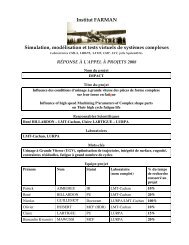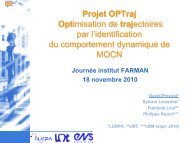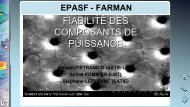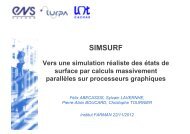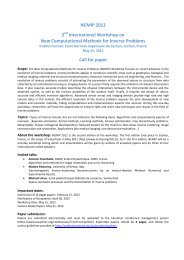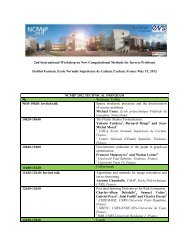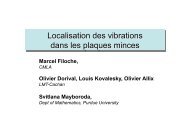DIGISCOPE 2010 Acronyme du projet - Institut Farman - ENS Cachan
DIGISCOPE 2010 Acronyme du projet - Institut Farman - ENS Cachan
DIGISCOPE 2010 Acronyme du projet - Institut Farman - ENS Cachan
You also want an ePaper? Increase the reach of your titles
YUMPU automatically turns print PDFs into web optimized ePapers that Google loves.
APPEL A PROJETS EQUIPEX /<br />
CALL FOR PROPOSALS<br />
<strong>2010</strong><br />
<strong>DIGISCOPE</strong><br />
SCIENTIFIC SUBMISSION FORM B<br />
1. SCIENTIFIC ENVIRONMENT AND POSITIONING OF THE EQUIPEMENT<br />
PROJECT<br />
The computing power available today is opening new doors for science, in<strong>du</strong>stry and<br />
society: Massive amounts of data, such as those generated by scientific instruments, sensor<br />
networks or business processes, can now be analyzed, mined and searched. Precise models<br />
of complex objects, from molecules to automobiles and aircraft, can be created, explored and<br />
manipulated. Massive simulations of complex physical, biological or meteorological<br />
phenomena can be run with high temporal and spatial resolutions.<br />
These data processing, modeling and simulation applications are vital for making new<br />
scientific discoveries as well as creating the pro<strong>du</strong>cts and services that will shape our future.<br />
However sheer computing power alone is not sufficient for these applications to achieve<br />
their potential. The ability of human users to easily control, analyze and understand the<br />
massive amounts of data that they manipulate is also critical for success. The key is to create<br />
an efficient coupling between the motor, perceptual and cognitive skills of humans and the<br />
storage and computational capabilities of computers.<br />
The main goal of <strong>DIGISCOPE</strong> is thus to provide users with more effective interaction with<br />
massive data and complex processes, better visualization of the current state and final result<br />
of large computations and improved collaboration among people performing these tasks.<br />
Over the past two decades, researchers have been developing tools for scientific visualization<br />
of physical phenomena, information visualization of abstract data, interactive modeling of<br />
3D objects, interaction with large display surfaces, and collaboration across time and space<br />
using mediaspaces and shared environments. However, it is only recently that these areas<br />
have started to converge, with the goal of creating integrated environments that can be used<br />
outside of laboratory settings.<br />
One strand necessary for this convergence is Data Visualization (Post et al., 2002). Data<br />
visualization is the emerging scientific field that combines scientific visualization (Friendly,<br />
2008), the visual representation of three dimensional phenomena (architectural,<br />
meteorological, medical, biological, etc.), and information visualization, the visual<br />
representation of large-scale collections of abstract quantities (Bederson & Shneiderman,<br />
2003; Friendly, 2008). To deal with the large amounts of data to display and understand, data<br />
visualization researchers and practitioners have created rooms with high resolution displays,<br />
e.g. Johnson et al. (2006), Mavris et al. (2005), Semeraro et al (2004), that allow more data to<br />
be visualized and explored by multiple researchers. Another approach advocates the use of<br />
distributed computing, to share visualization data among multiple researchers, e.g. Brodie et<br />
al (2004), COVISE 1 , in different geographical locations. Even so, few researchers address the<br />
problem of managing large-display visualization for multiple researchers in a room, with<br />
shared distributed visualization.<br />
A second strand of this convergence is Collaborative Virtual Environments (CVEs), which<br />
extend immersive virtual reality systems to support collaboration through shared<br />
environments. Benford et al (1994) con<strong>du</strong>cted early work on a spatial interaction model that<br />
captures the social dimensions that are relevant to such environments. Broll (1995) analyzed<br />
1 http://www.hlrs.de/organization/av/vis/covise<br />
6/95



